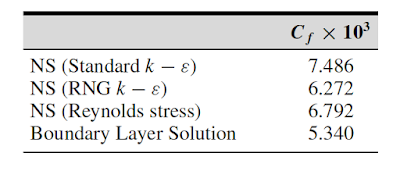DFS gives results in close agreement with observations as true prediction without adjustment of parameters to match each computation with observation in non-predictive mode. In particular, DFS uses a slip boundary condition on a smooth solid wall as a model of vanishingly small skin friction.
DFS thus computes the drag of a bluff body as form/pressure drag with vanishingly small contribution from skin friction, in close agreement with observation.
For a Naca0012 airfoil at zero angle of attack DFS delivers a drag coefficient $C_D =0.006$ as form/pressure drag, which fits well with untripped measurements (red) by Abbott and von Doenhoff:
The figure also shows measurement (blue) by Ladson with artificial tripping not present for a real wing with larger $C_D\approx 0.008$, thus not applicable to a real wing which does not carry any tripping device.
We now compare DFS with standard CFD where we find the following account in the standard reference Fundamentals of Aerodynamics 5th ed by John D Anderson p. 381 with reference in particular to Lombardi, G., Salvetti, M. V. and Pinelli, D.: Numerical Evaluation of Airfoil Friction Drag, J. Aircraft, vol. 37, no. 2, March–April, 2000, pp. 354–356:
- total drag 0.00623
- skin friction drag 0.00534 ($85\%$ of total)
into (see also this post):
- DFS: form/pressure drag $95-100\%$ of total drag.
- Standard CFD: form/pressure drag $15\%$ of total drag.
We see a vast difference of form/pressure drag with a factor 6! There is no way both DFS and standard can be correct.
We have massive evidence that DFS without parameters gives correct drag. The conclusion can only be that standard CFD does not capture anything like the truth.
Standard CFD includes turbulence and wall models with many parameters, with the wall model delivering large skin friction ($85\%$) of total drag. The parameters are then adjusted to give total drag in accordance with observations, which means that form/pressure drag comes out as a small portion ($15\%$) of total drag.
The conclusion can only be that standard CFD is not useful, acknowledged by many users, since by the necessity of parameter fitting is not predictive and does not capture true physics.
The reason standard CFD does not capture physics is rooted in the wall model used, which prescribes a separation pattern which is not physical. In DFS the separation is not prescribed by a model and instead follows the physics.
The reason standard CFD does not capture physics is rooted in the wall model used, which prescribes a separation pattern which is not physical. In DFS the separation is not prescribed by a model and instead follows the physics.
It is clear that aerodynamic design will be very different if based on predictive DFS with form/pressure drag dominating skin friction drag, instead of as now non-predictive standard CFD postulating dominating skin friction in contradiction with physics.
It is the same story in ship hydromechanics with a current consensus of $70\%$ skin friction drag and correspondingly small form/pressure drag, misleading design into (resultless) efforts to reduce skin friction.
PS More precisely John D Anderson reports the following results from Lombardi at al for NACA0012 at zero angle of attack at $Re =3\times 10^6$:
We see standard CFD delivering skin friction drag even larger than observed total drag.
It is the same story in ship hydromechanics with a current consensus of $70\%$ skin friction drag and correspondingly small form/pressure drag, misleading design into (resultless) efforts to reduce skin friction.
PS More precisely John D Anderson reports the following results from Lombardi at al for NACA0012 at zero angle of attack at $Re =3\times 10^6$:
We see standard CFD delivering skin friction drag even larger than observed total drag.






Inga kommentarer:
Skicka en kommentar